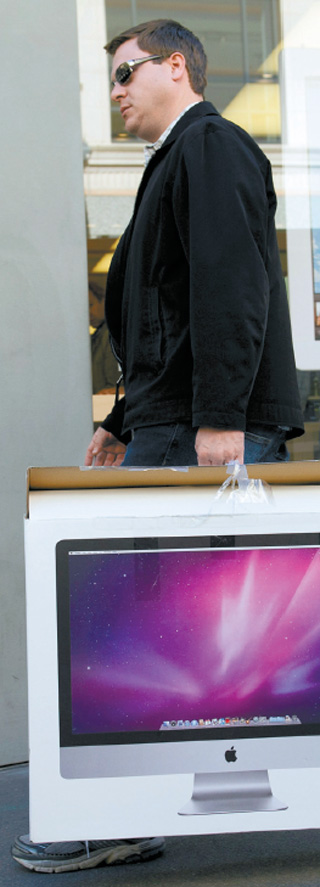Software revamp puts Apple exec under the gun

A customer carries a computer recently in front of an Apple store in San Francisco. [BLOOMBERG]
Already in charge of product design, Ive assumed oversight of the look and feel of software running all Apple electronics in a shakeup by Chief Executive Officer Tim Cook last year that included the departure of software chief Scott Forstall.
Ive, 46, has begun revamping iPhone and iPad applications, shunning realistic images, such as wood bookshelves for the Newsstand feature, and he’s exploring more dramatic changes to the e-mail and calendar tools, said the people, who asked not to be identified because the plans are private.
Ive is also methodically reviewing new designs, seeking to avoid a repeat of last year’s release of map tools that were widely panned, and he’s encouraging collaboration between the software and hardware divisions, which operated in silos under co-founder Steve Jobs, people said.
The introduction of new features, along with an emphasis on cooperation and deliberation, comes at a cost for Cupertino, California-based Apple. Engineers are racing to finish iOS 7, the next version of the mobile software, in time for a June preview at Apple’s annual Worldwide Developers Conference.
While the company still expects to release iOS 7 as soon as September, internal deadlines for submitting features for testing are being set later than past releases, people said.
Staff from Apple’s Mac team have also been roped in to help the mobile-software group finish the job. Apple has made similar moves in the past, including with the first version of iOS in 2007.
“Apple is really under tremendous pressure to come out with something different and something new,” said Greg Sterling, an analyst at Opus Research in San Francisco. Ive has “a tremendous sense of design, and he’s been the guru behind a lot of these enormously successful products, but he’s always had someone like a Jobs to push back on him and give him some guidance, and it’s not clear that Tim Cook is capable of playing that role. Maybe without a collaborator, he’s not as strong.”
Another possibility is that Apple’s next upgrade isn’t as robust or feature-rich as projected, and some changes come in future releases.
Ive is widely credited with working with Jobs to create the company’s most famous products, including the iPod, iPhone and iPad. Even so, his specialty has been hardware, designing a product out of materials like aluminum and glass - not software, which is based in code.
He also has shunned the spotlight, rebuffing overtures to figure more prominently at product events. Seeing Ive around Apple’s campus was akin to a celebrity sighting, according to a former manager. It’s not clear that Ive will be as effective as Jobs in getting teams to finish projects on time.
Cook elevated Ive in October, seeking to end clashes between Forstall and other senior managers that flared in the wake of the death of former CEO Jobs, people with knowledge of the matter said at the time.
The strife made it harder for teams to work together and threatened Apple’s ability to keep producing the types of electronics that made it the most valuable company in the world.
An operations expert who built Apple’s vast supply chain, Cook opted to leave the minutiae of product design to Ive amid intensifying competition from Samsung Electronics and Google.
The management shuffle in October tapped the brakes on work on the upgrade to iOS 7. New features typically submitted for testing around February ran a month or more behind schedule, according to one of the people with knowledge of the matter.
Software design involves the graphic style of images on the screen, as well as the deeper experience of how a user progresses through a given task, such as the steps needed for deleting an e-mail or entering a calendar item.
Apple hasn’t changed the look of many mobile-software programs like e-mail since the iPhone was introduced in 2007. Social-networking features are limited, and applications don’t always work well together, said Benedict Evans, an analyst at Enders Analysis in London. “There is a tidying up that needs to be done and a rethinking,” he said.
On top of that, Ive is moving the company away from layered and literal - or skeuomorphic - design elements, toward ones that are intended to give the software a flatter design that’s more unified and less cluttered. Bigger shifts, to such features as e-mail, may not be ready this year, sources said.
For now, the priority is getting mobile software done in time for the next iPhone, due to be released as soon as September.
Ive’s expanded influence comes at a critical time for Apple. Investors are anxious to see what new products the company will debut without Jobs’s leadership and as Samsung and Google improve their mobile products - and hire Apple’s employees to do it. One Apple engineer who left last year said he was quickly contacted by Samsung to invite him in to talk about ways the Korea-based electronics giant can improve its software. Google recently hired Steve Sinclair, a veteran iOS marketing manager, for its Motorola unit.
“The bar for good design has been raised and Apple is facing fiercer competition,” said Sarah Rotman Epps, an analyst at Forrester Research.
Bloomberg










with the Korea JoongAng Daily
To write comments, please log in to one of the accounts.
Standards Board Policy (0/250자)